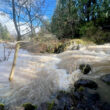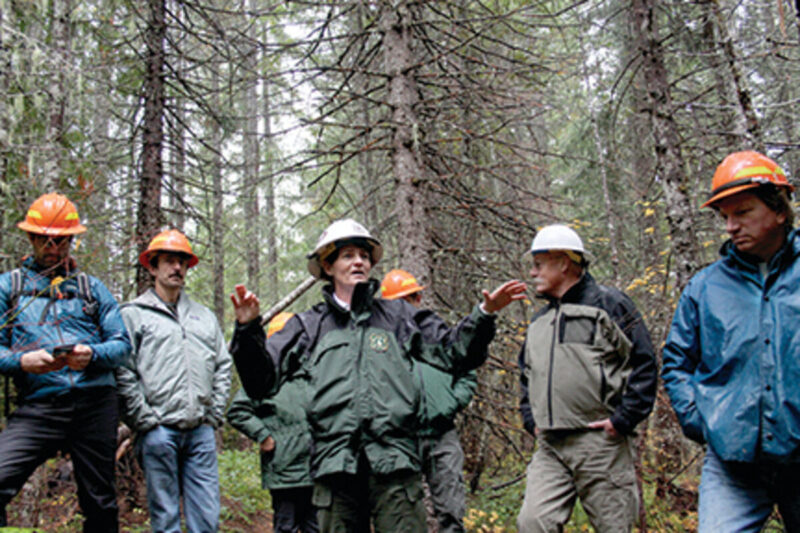Sarah Brown
Interdisciplinary staff of the Sweet Home Ranger District took a caravan of timber producers, public interest groups and the general public on a field trip through the Willamette National Forest Thursday to discuss proposals for the Quartsville-Middle Santiam project.
The task is to provide timber sales, structural and habitat improvement and fire resiliency.
“Primarily the areas we’re looking at are timber harvest in the form of thinning, and there’s also seven units for regeneration harvest (shelterwood with reserves) that are proposed,” said Nikki Swanson, district ranger.
Proposed aspects of the project also include fuels management, road maintenance and road decommissioning, she said.
“One of our jobs is a steady supply of timber,” Swanson said. “This district got behind a bit for a whole variety of reasons, and we’re not able to offer our 10 to 12 million board feet every year. So this project gets us ahead again. It gets us that shelf stock so that we’re not scrambling and I’m not working my people so hard. Then from there we can proceed at a more reasonable pace and maybe more efficient.”
Only in the beginning phases of the project, the Forest Service is preparing for a public scoping period that is expected to begin in December, said Joanie Schmidgall, planner for the National Environmental Policy Act. The field trip was a chance for the public to glimpse what is being proposed, share ideas, and ask questions.
“This is not necessarily required by the NEPA to do this, but this is something that we’re opting to do because we want to give the public an opportunity to see what we’re doing and we want to explain what we’re doing,” Schmidgall said.
The group visited three of the nearly 300 units, or stands, identified as potential locations for treatment.
There are several different land management allocations in the project area that determine the objective for those sections of land. The northern two thirds of the QMS project include late successional reserves (LSR), while the southern third includes matrix land allocations.
The job of LSR is to grow bigger, older forests with old growth habitat characteristics, Swanson said. In this case, they were reserved for the northern spotted owl, as well as other certain plant and animal species.
“What we want out here is spatial diversity and species diversity,” said Autumn Metz, silviculturist for the Forest Service. “We want to grow big trees out here, and we want those trees to have good structure, and to have enough space to elongate their crowns and grow large branches.”
To achieve those objectives, in short, the Forest Service proposes a commercial thinning of overstocked trees followed by production of snagged trees and downed wood.
Matrix allocations, which neighbor private timber lands, are intended to provide a steady supply of timber for the American public. Proposals for sustainable treatment include commercial thinning, gap creation, dominant tree release, and shelterwood with reserves.
“So where we are in the process, we’ve identified the spots we want to do vegetative treatment, and we’re at the phase of the project where we’re doing scoping,” Swanson said.
The Forest Service team listened to questions and concerns from those in the group.
Doug Heiken, of Oregon Wild, noted that forests don’t require human intervention of thinning in the LSR to do what comes naturally.
“We don’t have to export the trees that die in the forest, and we don’t have to choose which trees die in the forest. We can just let nature sort it out, and that’s okay,” Heiken said. “I just want to make sure we have a good ecological input to the thinning prescriptions. I support thinning in stands like this, but I don’t want to see mortality as a bad thing, and I don’t want to see logging as some kind of fuel solution when it really probably isn’t that big of a deal.”
Following some conversation, Andy Geissler, federal forest manager at the American Forest Resource Council, pointed out that trade offs are made in decisions like these.
“You guys (foresters) are thinking about the trade off from cutting a tree and putting it on the truck and turning it into a board, as opposed to leaving it out here to die,” Geissler said. “Part of that trade off is what you’re getting, as far as late seral habitat acceleration, which is really the overall goal of the project.”
While at unit 166, located in a matrix area, Reed Wilson, volunteer with the Northwest Ecosystems Survey Team, talked about some of his concerns regarding regeneration harvesting.
“We’re talking about a stand that has not been previously logged, and it’s providing many of the values that the public is short of because we logged too much in the past, and we haven’t yet recovered our LSRs,” Wilson said.
“Our LSRs are still full of plantations because they were heavily cut before we got the Northwest Forest Plan, and yet here we have a matrix of beautiful mature forest that is managing itself and turning into old growth before our eyes, and it’s very controversial to sacrifice that while we still haven’t recovered our LSRs yet.”
He said unit 166 includes silver firs, western white pines and chinkapins, as well as a snag tree located just up the path from the group that houses a red tree vole nest.
Again, Geissler stepped in to explain his understanding that the Sweet Home District likely hasn’t “regen harvested” much since the Northwest Forest Plan was signed.
“At some point you’re going to have to regen in Doug Fir forests, it’s a reality,” he said. “And you’re going to have to do it somewhere in the matrix, which is where you are assigned to do it. That’s the only place you can do it. We can’t go into those plantations over there in the LSR and regen because it’s LSR. So we’re here in this small area of matrix, and this is where you guys need to be doing regen harvest, and I’d say it’s about time. We haven’t done any of it since probably the early 90s.”
The blocks of land in the matrix, including where unit 166 sits, are intermingled with the private timber lands, and are thus determined to not be good habitat for wildlife, Metz noted.
“I don’t like to see older forests removed. There’s a small percentage of it left,” Wilson said.
He takes a particular interest in animal species that dwell in old growth habitats.
“The red tree vole is an indicator species of the health of the habitat, of the ecosystem,” he said.
As a ranger, Swanson said she likes it when there is broad representation in the decision making process because it helps her as a decision maker to see the full range of perspectives.
“That being said, we probably don’t all have the same values, and that’s okay. We manage this land for the American public, and the American public does not have the same set of values.”
After hearing concerns and interests from the tour party, the forest service expects to draft a very basic proposal for the QMS project that should be available for public scoping some time in December, Schmidgall said. It will be a preliminary action project proposal.
At that time, the public can provide feedback, and the staff will address each comment. By the following mid-summer, a document will be available for further public review and comment. Then another refined version will be produced and made available for a 45 day objection period.
The forest service hopes to have a final, signed decision by Spring 2021.
“This is the National Environmental Policy Act system at work. It allows us to do a system analysis, and it also allows for a lot of public involvement, which is really important because we’re on public land,” Schmidgall said. “It just takes a while, and I think it’s really important to allow people to be involved. This is public lands and everyone needs to have a voice.”





